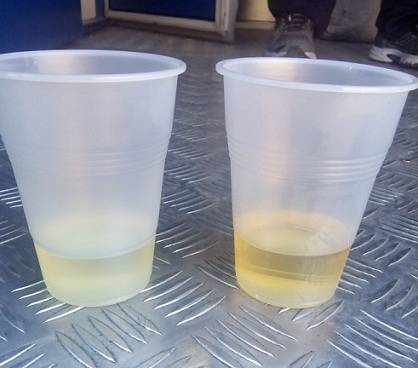Lubricating oil is practically always exposed to contamination during operation of machinery. Wear and tear are the first cause of contamination. Contaminated oil loses its resistance to oxidation, loses its lubricating properties and increases wear of the rubbing surfaces.
Lubricating oil is constantly under the influence of high temperatures, atmospheric oxygen and deterioration products. The most intensive oxidation of lubricating oil occurs above 70°C, resulting in development of low-molecular water-soluble acids. They cause corrosion of metal surfaces, tarry deposits, insoluble compounds, etc.
After the expiry date – oil loses its properties, and it is normally drained from the system. The collection of waste oil is carried out by a team of oilers. Each type of oil is collected into a separate container. It is sent to a storage facility of gas and lubricant materials. Only after it can be sent to oil reclaiming enterprises.
The number of individual containers must be equal to the number of drained oil. But there are exceptions. Different varieties of spindle oil, machine oil, cleaned and extracted/leached oils and waste oils with the same base can be drained into one container.
Removed from waste oil are:
- mechanical impurities;
- fuel fractions;
- water;
- organic acids;
- neutral and acidic resin;
- asphaltenes.
Reclaiming of waste oil is done by following methods:
- filtration and sedimentation;
- contact purification and filtration;
- fuel distillation, contact purification and filtration;
- fuel distillation, contact purification and filtration;
Each oil reclamation method is preceded by settling the waste oil in a tank with a conical bottom in order to separate solids and water.
Waste oil products are divided into groups: WMO – motor oil, WIS – industrial oil, WOOD – oil discharge.
Oil Recycing of WMO and WIS is removing mechanical impurities and water, as well as stripping of light fractions. The process is accomplished by alkali or contact purification.
Gear oils properties are restored by a combination of sedimentation and filtration methods, that may be considered the simplest way of recycling, but only used for gear oils.
Contact purification and filtering method have following stages:
- initial oil processing using bleaching clay and water in order to obtain water-oil emulsion;
- separation of water and fuel from oil;
- oil filtration followed by its mixing with an additive.
As mentioned above – waste oil is sent for recycling to specialized enterprises. This is not always convenient. Besides, there is a repeated transport costs.
GlobeCore offers a unique solution to waste oil recycling for small and medium oil facilities. No need to buy huge expensive equipment with high capacity. Small-sized mobile GlobeCore oil treatment plant – is compact and reasonably priced. It is used for recyling of oil in place of its operation. GlobeCore technologies restore the original purity of waste oil for its further use.
Proper oil collection and oil regeneration at your own facilities can reduce the consumption of fresh oil by 15-20% significantly save costs. Because, the cost of reclaimed oil is approximately 1.3 times lower than the cost of fresh oil.

